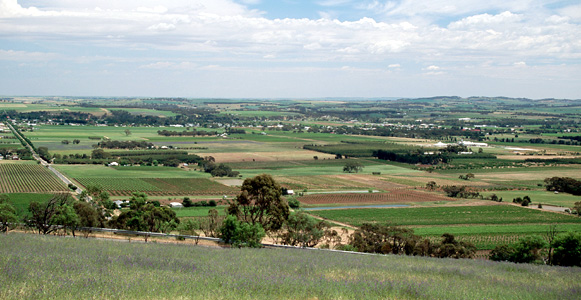Barossa, << bah ROH suh, >> Valley is one of Australia’s main wine-producing areas. It is actually the valley of the North Para River, but the British explorer and surveyor Colonel William Light named it Barrosa, after the site of a British victory in the Peninsular War (1808-1814). The name of the valley later became Barossa after it was spelled incorrectly on official documents. The valley is about 25 miles (40 kilometers) long and 20 miles (32 kilometers) wide. It lies about 35 miles (56 kilometers) east of Adelaide, in South Australia. To the east, low hills rise sharply to as much as 2,300 feet (700 meters) above sea level. The valley has a Mediterranean climate, with an average rainfall of more than 20 inches (50 centimeters).

Wine.
The Barossa Valley is known as the Valley of the Vine because it produces more than 20 percent of Australia’s wine. More than 30,000 acres (12,100 hectares) of vineyards grow on its rolling hillsides and on the fertile alluvial land (formed from soil deposited by rivers). It is one of the largest concentrations of nonirrigated vines in Australia.
There are more than 75 wineries in the valley, ranging from major businesses, such as Orlando, Yalumba, and Seppelt, to small family or cooperative establishments. Each large winery has developed its own vineyards. But independent vignerons (wine producers) also make an important contribution to the valley’s fame. They own holdings of 50 to 125 acres (20 to 50 hectares) and farm them intensively.
The people.
About 30,000 people live in the Barossa Valley. Large numbers live in the towns of Tanunda, Angaston, and Nuriootpa. The rest live in smaller towns and farm settlements throughout the area. Farmers produce cereal crops, meat, vegetables, and wool. Many people work in the production of such specialty foods as German sausages and pastries.
Many of the people are descended from the German settlers who first occupied the area. These people brought a strong Lutheran faith to the valley, and the towns have many Lutheran churches. The valley was relatively isolated for many years, and the people spoke a mixture of German and English called Barossa Deutsch. Today, few people speak Barossa Deutsch, and those who do are generally older. Many of the towns still have distinctive German architecture.
History.
People from Prussia and Silesia settled in the valley in 1841. They had come to South Australia under the leadership of Pastor August Kavel, who arrived in South Australia in 1838, to escape religious persecution in Germany. George Fife Angas, a director of the South Australian Company, owned about 28,000 acres (11,300 hectares) of land in the Barossa Valley. A deeply religious man, Angas assisted the immigrants who settled at Bethany and Langmeil.
The immigrants established a series of small villages with such names as Gnadenfrei, Kaiser, Krondorf, and Stuhl. The settlers began farming to provide meat, fruits and vegetables, and wheat for themselves. They built wooden homes and barns with thatched roofs. They tried to make the valley as much like their homeland as possible.
The German-born geologist Johann Menge first drew attention to the potential for growing vines in the valley. Johann Gramp and Samuel Hoffman planted the first vines near Jacob’s Creek in 1847. Gramp produced the first Barossa wine in 1850. Joseph Gilbert, Joseph Seppelt, and Samuel Smiths followed his lead.
See also South Australia (Agriculture).
